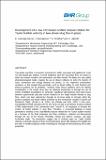Development of a New Cfd-Based Unified Closure Relation for Taylor Bubble Velocity in Two-Phase Slug Flow in Pipes
Author(s)
Lakehal, D.; Lizarraga-Garcia, Enrique; Buongiorno, Jacopo; Alsafran, Eisa
DownloadBuongiorno_Development of a new.pdf (933.1Kb)
OPEN_ACCESS_POLICY
Open Access Policy
Creative Commons Attribution-Noncommercial-Share Alike
Terms of use
Metadata
Show full item recordAbstract
Two-phase slug flow is a common occurrence in wells, riser pipes and pipelines of crude oil and natural gas systems. Current predictive tools for two-phase flow are based on either the mixture model or the mechanistic two-fluid model. The latter one, also called phenomenological model, requires the use of closure relations to solve the transfer of mass, momentum and energy between the phases, in the respective conservation equations, so that integral flow parameters such as liquid holdup (or void fraction) and pressure gradient can be predicted. How ever, these closure relations carry the highest uncertainties in the model, since they are obtained empirically or through the use of overly simplified assumptions. In particular, significant discrepancies have been found between experimental data and closure relations for the Taylor bubble velocity in slug flow, which has been determined through an in-house study to strongly affect the pressure gradient and liquid holdup predicted by the mechanistic models of (Orell and Rembrand, 1986), (Ansari et al., 1994), and (Petalas and Aziz, 2000). In this work, Computational Fluid Dynamics (CFD) and the Level Set (LS) interface tracking method(ITM), implemented in the commercial code TransAT®, are mployed to simulate the motion of Taylor bubbles in slug flow. Therefore, a numerical database is being generated to develop a new, high-fidelity closure relation for the Taylor bubble velocity as a function of the fluid properties and flow conditions, rendered non-dimensional through the use of the Froude, Reynolds, Eötvös and Morton numbers, and pipe inclination angle. The simulations suggest that in inclined pipes the Taylor bubble velocity is strongly reduced if there is no lubricating liquid film between the bubble and the wall. A simple analytical model predicting the drainage of this lubricating film is also presented.
.
Date issued
2015-06Department
Massachusetts Institute of Technology. Department of Mechanical Engineering; Massachusetts Institute of Technology. Department of Nuclear Science and EngineeringJournal
17th International Conference on Multiphase Technology 2015
Publisher
Curran Associates, Inc.
Citation
Lizarraga-Garcia, E., J. Buongiorno, E. Al-Safran and D. Lakeha. "Development of a new CFD-based unified closure relation for Taylor bubble velocity in two-phase slug flow in pipes." 17th International Conference on Multiphase Technology 2015 (June 2015), pp. 93-107. ©2015.
Version: Final published version
ISBN
978-1-5108-1144-7